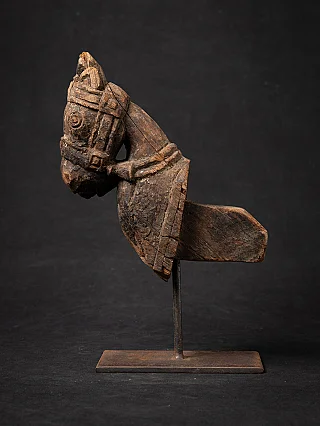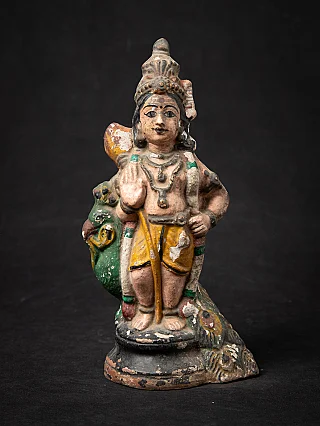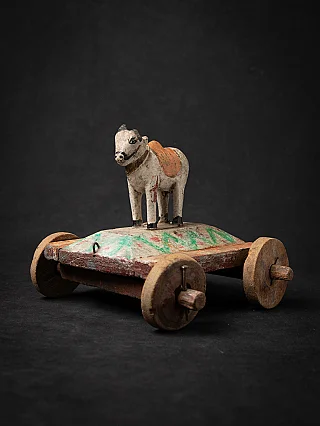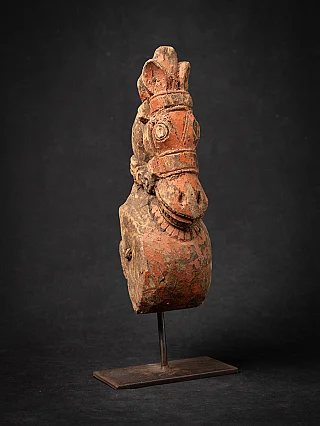Lord Indra - King of the Devas
Author : Peter Vredeveld

Lord Indra Depicting as the wielder of the Thunderbolt riding on Vahana Airavata and defeating Vrtra.
One of the world's oldest religions, Hinduism boasts a pantheon of diverse and revered deities. Lord Indra, the king of the gods, stands at the forefront of this divine hierarchy. Exploring the intricacies of Lord Indra's character not only unravels the richness of Hindu mythology but also reveals the cultural and spiritual significance embedded in the worship of this celestial figure.
Background of Lord Indra
Origin and Mythology:
Lord Indra's roots are firmly planted in the Vedic scriptures, especially the Rigveda. Born to the sage Kashyapa and the primordial goddess Aditi, his divine lineage sets the stage for a mythic narrative of cosmic significance. The Rigveda sings hymns praising Indra's valor, recounting his legendary battles against the serpent demon Vritra. This epic clash establishes Indra as a heroic figure and the vanquisher of chaos.
Role in the Hindu Pantheon:
Beyond the Rigveda, Lord Indra's role in the Hindu pantheon is multifaceted. As the ruler of Svarga, the heavenly abode, he governs with regal authority and martial prowess. Indra emerges not only as a warrior defeating demonic adversaries but also as the upholder of dharma, ensuring that cosmic order and righteousness prevail.
Attributes and Depictions

Physical Appearance:
Lord Indra is often depicted with regal splendor. His robust and youthful form exudes strength and vitality. Indra is adorned with divine ornaments, and his countenance reflects wisdom and authority, befitting his role as the king of gods.
Symbolic Elements:
Indra's symbolism extends to his mighty weapon, the Vajra, a thunderbolt representing destructive force and indestructible purity. His mount, Airavata, the celestial white elephant, symbolizes majesty and purity, further enhancing the divine aura surrounding Lord Indra.
Iconography and Representations in Art:
In artistic representations, Lord Indra is portrayed in various mediums. Paintings, sculptures, and temple carvings capture his dynamic presence, often surrounded by celestial elements and mythic symbolism. These depictions serve as visual narratives, conveying the essence of Lord Indra's divinity.
Titles and Epithets
Lord Indra is adorned with various titles and epithets, each illuminating different facets of his divine persona. As "Shakra," he is mighty, symbolizing strength and power. "Vajrapani" emphasizes his wielding of the thunderbolt, while "Meghavahana" highlights his association with clouds and rainfall, crucial for agricultural prosperity.
Roles and Responsibilities
Leadership in the Heavenly Abode:
Svarga, the celestial realm ruled by Indra, is a realm of divine splendor and eternal bliss. As the king of gods, Indra leads the celestial beings in a harmonious existence, reflecting the cosmic order envisioned in Hindu cosmology.
Protector of Dharma:
Indra's role extends beyond the celestial realms; he is a guardian of dharma, ensuring the preservation of moral and cosmic order. His interventions in the cosmic balance, often through epic battles, exemplify his commitment to righteousness and the greater good.
God of Rain and Thunderstorms:
Indra's influence is felt in the natural world through his association with rain and thunderstorms. Devotees invoke him for bountiful rainfall, crucial for agricultural abundance. This aspect of Lord Indra reinforces his connection to the cyclical rhythms of nature.
Mythological Stories

Indra in Major Hindu Epics:
Indra's presence is vividly felt in major Hindu epics such as the Mahabharata and Ramayana. He plays a pivotal role in the Mahabharata, supporting the Pandavas and contributing to the grand narrative of the Kurukshetra War. In the Ramayana, his involvement surfaces during critical events, showcasing the interconnectedness of Hindu mythological stories.
Stories Depicting Indra's Challenges and Triumphs:
The mythological lore surrounding Lord Indra is replete with tales of challenges and triumphs. His battles against formidable foes, both demonic and divine, highlight his resilience and courage. These stories entertain and impart moral lessons, emphasizing the victory of good over evil.
Worship and Festivals

Temples Dedicated to Lord Indra:
Devotees express their reverence for Lord Indra through temples dedicated to his worship. Notable among them is the Devaraja Swami Temple in Karnataka, India. These sacred spaces serve as focal points for rituals, prayers, and festivals dedicated to the king of gods.
Festivals Associated with Indra Worship:
Indra's worship is intertwined with specific festivals. The most significant is Indra Puja, celebrated fervently in regions like Odisha. Devotees engage in elaborate rituals, processions, and cultural events to honor and seek the blessings of Lord Indra.
Rituals and Ceremonies Specific to Indra:
Devotional practices for Lord Indra involve intricate rituals. These may include reciting Vedic hymns, yajnas (fire rituals), and offering specific items such as flowers and Soma. These ceremonies are conducted with precision to invoke Indra's divine presence.
Indra and Devotees
Devotee Experiences and Testimonials:
The devotion to Lord Indra is deeply personal for many followers. Devotees often share their experiences and testimonials, recounting moments of divine intervention, blessings, or personal transformation attributed to their connection with Indra.
Devotional Practices and Prayers Dedicated to Indra:
Devotees engage in various devotional practices to express their reverence for Lord Indra. These may include daily prayers, meditation, and participation in community rituals. Specific prayers, such as the Indra Gayatri mantra, are recited to invoke his blessings.
Lord Indra and Other Hindu Dieties
Relationships with Other Hindu Deities:
Lord Indra's relationships with other Hindu deities reveal intricate connections. His interactions with gods like Brahma, Vishnu, and Shiva showcase the collaborative nature of divine forces in maintaining cosmic order.
Distinctive Features Compared to Other Gods:
While Indra shares common attributes with other deities, he possesses distinctive features that set him apart. His role as a warrior-king and god of thunderstorms distinguishes him, contributing to the diverse tapestry of Hindu mythology.
Cultural Impact
Influence on Art, Literature, and Music:
Lord Indra's influence extends beyond religious worship and permeates various cultural expressions. Artists, writers, and musicians drew inspiration from his mythology, depicting his stories in paintings, composing hymns, and incorporating his tales into literary works.
Depiction of Indra in Different Regional Cultures:
The diversity of Hindu traditions is reflected in the regional variations of Lord Indra's depiction. Different cultures may emphasize specific aspects of his character or highlight unique narratives, contributing to a rich mosaic of interpretations across the Indian subcontinent.
Symbols and Artistic Representations
Exploration of Symbols Associated with Indra:
Delving into the symbols associated with Lord Indra reveals layers of meaning. The Vajra, representing thunderbolt and diamond, symbolizes his destructive and indestructible nature. Understanding these symbols adds depth to the appreciation of Indra's divine attributes.
Analysis of Artistic Representations in Different Cultures:
Artistic representations of Lord Indra vary across different regions and historical periods. Analyzing these variations offers insights into this revered deity's evolving cultural and creative interpretations.
Controversies and Misunderstandings
Addressing Controversies or Misconceptions:
Lord Indra is not exempt from controversies or misconceptions as with any prominent figure. Some narratives or interpretations may lead to clarification. Addressing these controversies helps provide a more nuanced and accurate understanding of Lord Indra's place in Hindu mythology.
Clarifying Common Misunderstandings About Lord Indra:
Clarifying misconceptions is crucial for fostering a more accurate appreciation of Lord Indra. Whether related to his role in myths or his cultural significance, dispelling misunderstandings contributes to a clearer understanding of this deity.
14 Manus Forms of Indra
Spread of Indra Worship Outside of India:
The worship of Lord Indra extends beyond the borders of India. His presence in various diaspora communities and through global interest in Hinduism is acknowledged and celebrated in diverse cultural contexts.
International Festivals and Events Dedicated to Indra:
Indra's influence transcends geographical boundaries. International festivals and events dedicated to Lord Indra showcase the global resonance of his mythology and the universal appeal of his divine attributes.
According to the Markandeya Purana, each Manu period or Kalpa is associated with a specific Indra, resulting in 14 forms of Lord Indra. The succession of Manus and their corresponding Indras is outlined as follows:
- Svayambhuva Manu – Yajna Indra:
Yajna Indra presides over the era of Svayambhuva Manu, the first Manu in the cosmic cycle.
- Swarochish Manu – Vipaschit Indra:
Vipaschit Indra governs the period of Swarochish Manu, contributing to the cosmic order.
- Uttam Manu – Sushanti Indra:
Sushanti Indra held sway during the reign of Uttam Manu, overseeing a harmonious epoch.
- Tamas Manu – Shibi Indra:
Shibi Indra presides over the era of Taamas Manu, ensuring balance and justice.
- Raivat Manu – Vibhu Indra:
Vibhu Indra governs the period of Raivat Manu, contributing to divine harmony.
- Chaakshush Manu – Manojav Indra:
Manojav Indra rules during Chaakshush Manu, symbolizing swift and decisive action.
- Shraaddhdev Manu – Purandar (Present Lord Indra):
The present Lord Indra, known as Purandar, governs the epoch of Shraaddhdev Manu.
- Savarni Manu – Bali Indra:
- Bali Indra oversees the period of Savarni Manu, contributing to the cosmic balance.
- Dakshya Saavarni Manu – Adbhut Indra:
Adbhut Indra governs during the reign of Dakshya Saavarni Manu, bringing awe-inspiring aspects to the cosmic order.
- Brahma Saavarni Manu – Shanti Indra:
Shanti Indra held sway during the Brahma Saavarni Manu period, representing peace and tranquility.
- Dharma Saavarni Manu – Vish Indra:
Vish Indra presides over the era of Dharma Saavarni Manu, symbolizing virtue and righteousness.
- Rudraputra Saavarni Manu – Ritudhaama Indra:
Ritudhaama Indra governs during the time of Rudraputra Saavarni Manu, contributing to the cycles of seasons and nature.
- Ruchi (Deva Saavarni) Manu – Devaspati Indra:
Devaspati Indra oversees the Ruchi (Deva Saavarni) Manu period, symbolizing divine lordship.
- Bhaum (Indra Saavarni) Manu – Suchi Indra:
Suchi Indra rules during the Bhaum (Indra Saavarni) Manu period, contributing to the cosmic order with purity and brilliance.
The intricate alignment of each Manu with a specific form of Lord Indra adds a profound layer to the cyclical nature of Hindu cosmology. Each Indra contributes uniquely to the cosmic harmony during their respective epochs.
Indra in Buddhism

Indra plays a significant role in Buddhist myths, creating a distinctive place in Buddhist cosmology. According to Buddhist tradition, Indra holds the esteemed position of ruler of the Trayastrimsa Heaven and is commonly known by the name Sakra or Sakka. Notably, the portrayal and significance of Indra in Buddhist myths diverge considerably from their Vedic counterparts.
Contrary to the Vedic narrative, Buddhist cosmology asserts that "Sakka and Indra are independent conceptions. None of the personal characters of Sakka resembles that of Indra." In Buddhism, Sakka is a distinct celestial figure with unique attributes, detached from the characteristics traditionally associated with the Vedic deity Indra.
In Chinese Buddhism, Sakka is called "Dishitian" or "Shiti Huanyin." At the same time, the name "Taidhakuten" is used in Japanese Buddhism. These variations underscore the adaptation and localization of celestial beings across different Buddhist cultures.
Moreover, Indra in Buddhism is intricately linked with Vajrapani, a revered figure recognized as the Defender and Protector of Dharma, the Buddha, and the Sangha. This association highlights Indra's role as a guardian of Buddhist principles, symbolizing the strength and resilience required to uphold the teachings of Buddhism.
The mythological landscape of Buddhism weaves a unique tapestry around Indra, emphasizing his distinctiveness from the Vedic Indra and highlighting his role as a celestial force aligned with the principles of Dharma in Buddhist cosmology.
Share this page














































